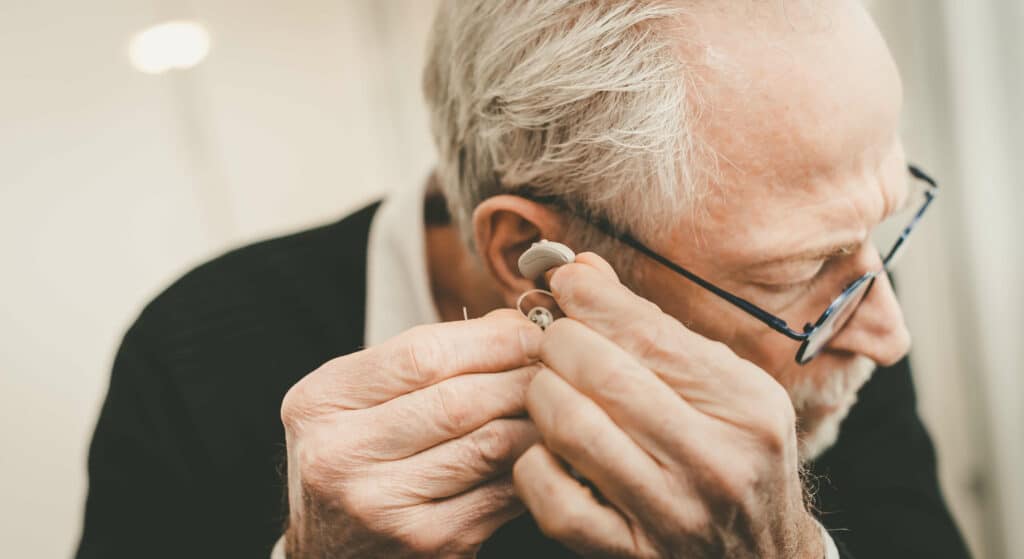The FDA recently approved over-the-counter hearing aids. You may be wondering what this means for you in your pharmacy. Kevin Hope, RPh, our Senior Director of Pharmacy Education, explains what you and your patients need to know about OTC hearing aids.
Over The Counter Hearing Aids: Ask the Pharmacist!
An elderly gentleman in the pharmacy was bragging about his new hearing aid and how well it was working. “What kind is it?” the technician asked. The man looked at his watch and said, “4:30”.
From memes to comedic antics, hearing loss seems to be an unending source of material for comedians pointing out the fallacies of misinterpretation. For patients with hearing loss, however, the frustrations take a very real toll on well-being. One American Academy of Audiology survey found that those with untreated hearing loss were more likely to report depression, anxiety, and paranoia and were less likely to participate in organized social activities compared to those who wear hearing aids. Strikingly, the National Institute on Deafness and Other Communication Disorders reports that one in three people in the U.S. between the ages of 65 and 74 has some degree of hearing loss, with nearly half of those older than 75 impacted.
Of patients impacted in the United States, only about 20% of patients with hearing loss get help for the problem, which can contribute to dementia and other complications if left untreated. One of the barriers commonly cited is cost. Most physician/audiologist-prescribed hearing aids cost between $4,000 and $5,000, with insurance covering little to none of the expense in many cases.
Over the counter hearing aids are FDA-approved
In October 2022, the FDA issued a final ruling that will make the devices available on an OTC basis, significantly reducing the costs associated with procuring a hearing aid. In contrast to previous options, patients now have ungated access to devices within the $500 to $1,000 per device range. The FDA ruling applies to certain types of air-conduction hearing aids, which are worn behind or inside the ear.
Can a patient walk in off the street and buy a hearing aid without a Doctor?
The FDA has added a number of specifications for the aids that will be sold over the counter to have:
- User-adjusted volume controls
- A lower maximum sound output to control the over-amplification of sound
- Revising the insertion depth limit in the ear canal
- Patient-friendly instruction language
Of course, over the counter options are not recommended for all patients. Some patients will still require professional assistance. Patients meeting any of the following criteria should be referred to an audiologist:
- I am younger than 18 years old
- I hear much better in one ear than in the other ear
- In the last 6 months, I suddenly cannot hear out of one or both ears as well as I used to
- I have ringing, roaring, or beeping in one or both of my ears
- I have a history of taking medications that cause hearing loss
- I have a history of chemotherapy and/or radiation in the head and neck region
- In the last 6 months, I have noticed active drainage from one or both of my ears
- I have constant pain or discomfort in one or both of my ears
- I experience dizziness
Pharmacists are well-positioned to assist patients in determining if an over-the-counter device might be an appropriate choice. Patients are reminded that unexplained hearing loss may be attributable to a number of factors, ranging from simple wax accumulation to complex medication side effects with permanent ramifications. Sudden hearing loss should not be ignored.
How do hearing aids work? What’s inside? Watch this video from Pete Kreckel, RPh, to learn more
What I’m going to do is a little demonstration showing you hearing aid maintenance. I’m going to take my hearing aid out of my ear, hold it up to the camera and, as you can see, this fat gray part that goes behind my ear is what collects the sound and amplifies it.
Now the kind I have is a RIC, a Receiver in Canal. This is not a tube, this is a wire, and this wire connects to this speaker. This speaker then goes inside my ear and then it goes next to the eardrum, so the sound bounces off of my eardrum. But the good news with this kind of hearing aid is that it’s a thin wire and just a small tube that looks like a parachute, and it doesn’t lay against the ear but more in the center of the ear canal.
The first thing I want to show you is how to change the hearing aid battery. Most of them just flip down like this. Give it a whack with your hand, the battery comes out, and then you have your empty cavity here. You’ve probably seen them all in your stores, but these are our hearing aid batteries. They come with these tabs—and tell your patients not to take the tabs off until they’re ready for use. Ideally you open them, but in the interest of time you want to wait about 30 seconds or a minute before you put it in. If you look real close, there’s three tiny holes that allow the air to go in and that’s what activates the hearing aid battery.
So we’re going to pick up our hearing aid, we’re going to slide our battery into that compartment, and we’re going to close it until you hear a big click. Hearing aid battery change has to be done frequently, depending on the quality of hearing aid batteries you have and how loud your amplification is. I get about six days out of a battery, some people get three days, and some people will get more than that.
The second thing that we need to do is clean the wax trap. I’m going to pop the cone off and now, if you can see real close, that little white gizmo is called a wax trap. This wax trap has to be removed and taken out. You see that small hole in it? Now can you imagine somebody with the dexterity of a 90 year old doing this? But they make it pretty easy!
This is your wax trap loading device. Each one comes pre-loaded with the white on that end and the black nub on the other end. You insert the black nub end in, give it a little push, and then a twist. There! I popped it off. Now we’re going to flip it around to the new wax trap. We’re going to slide it in and again just bend and take it off. Now I’ve replaced the wax trap. Then I’m going to grab a nice new fresh cone—it’s just a rubbery thing—and it slides on like this. Now we have a new fresh cone and a new wax trap.
It’s really important that we replace these every so often, because if you get a wax occlusion in there, it kills the hearing aid entirely. The first time that I ever had my hearing aids, within a week the one died. I said, “What is wrong? Oh, I know! Replace the wax trap.” So I replaced the wax trap, but it still didn’t work. So took it to the audiologist and there was a chunk of wax stuck in the cone that occluded all of my hearing. So, change the cone, change the wax trap and then if that doesn’t work, then we can contact the manufacturer.
Are you looking to learn more about OTC hearing aid education? freeCE can help!
If you are working in a community or retail pharmacy, this new ruling from the FDA may impact your day-to-day practice. You might be looking for more in-depth education to help you guide your patients in choosing a device. If you would like this kind of CE, freeCE can help! We have a live webinar from OTC expert Pete Kreckel, RPh, designed to give you the information you need to meet this new opportunity for patients. To catch an airing of this acitivty, sign up for a freeCE Gold membership, which gives you unlimited access to our live and on-demand calendar.
In general, OTC products can be overwhelming to patients. With so many options to meet so many common concerns, patients may come to you for guidance—and you might need some guidance yourself! If you’d like to learn more about the many products available on your pharmacy’s shelves, try freeCE’s specialty certificate series from Dr. Pete Kreckel, Self-Care Specialist, which provides 20 hours of CE credit and gives you in-depth education on many OTC products. For unlimited access to all specialty certificates (and live and on-demand CE!) register for a freeCE platinum membership.







